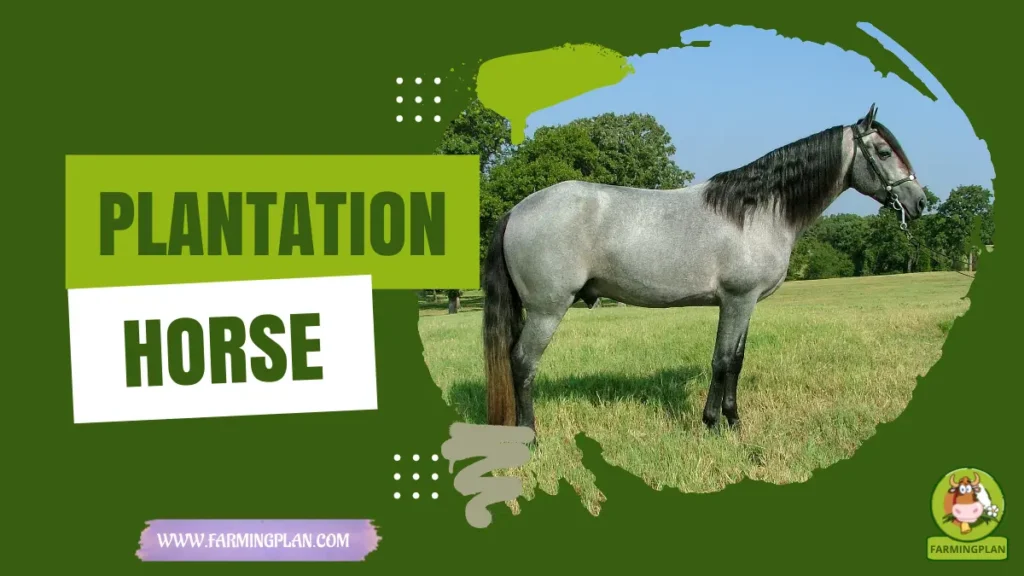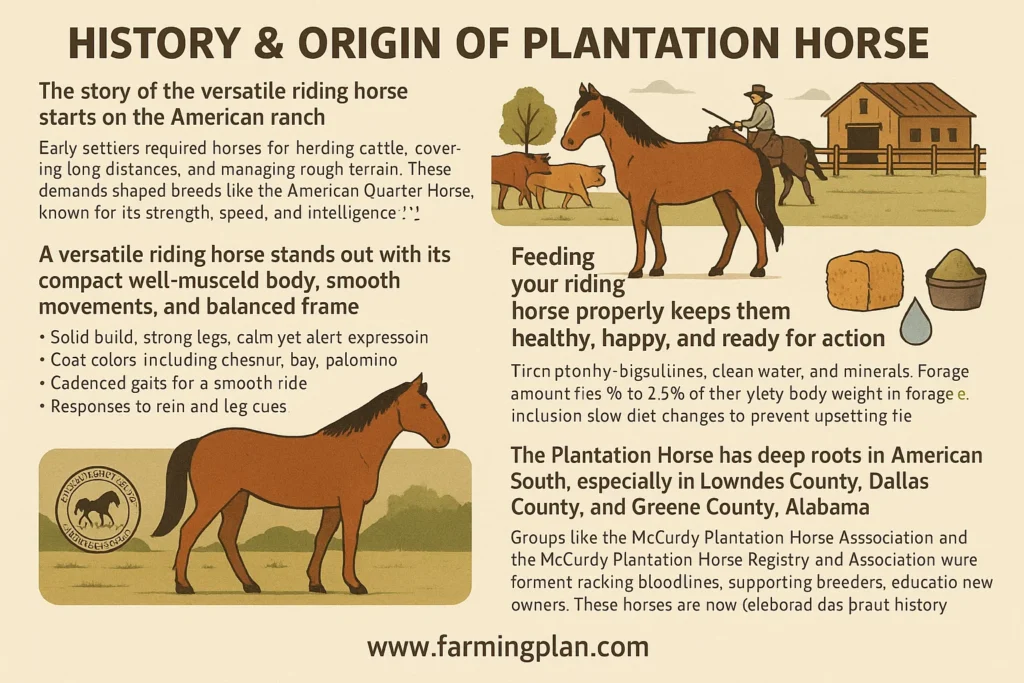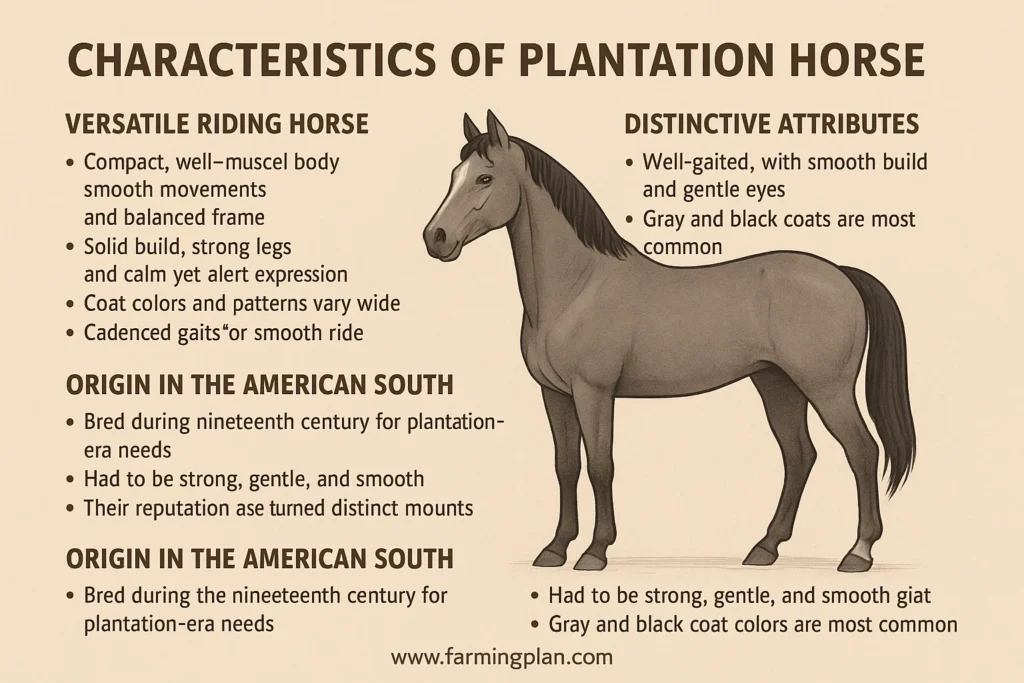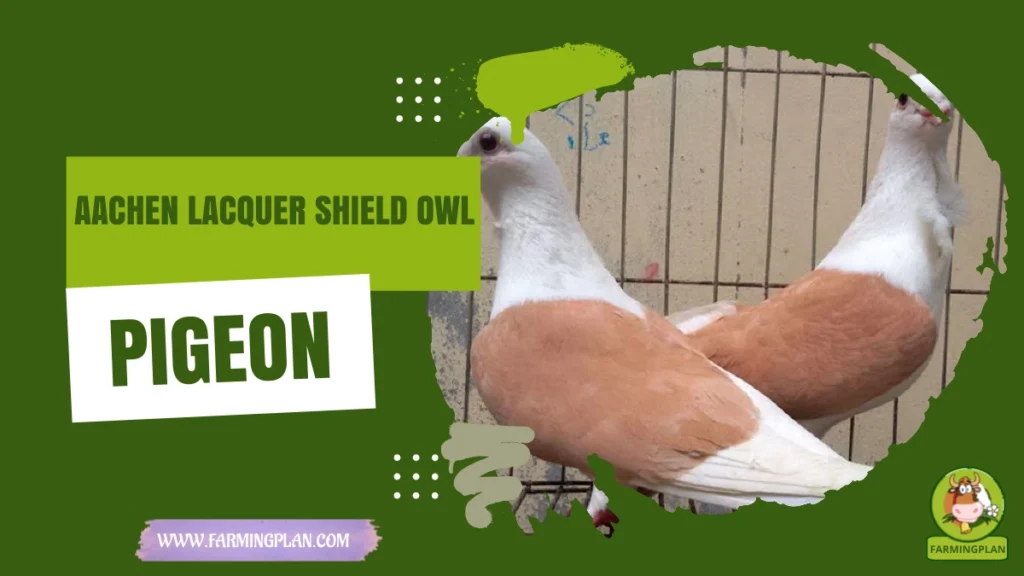The Plantation Horse is more than just a beautiful animal—it’s a living piece of American history. Known for its smooth, natural gait and calm nature, this special breed was once the top choice for plantation owners, trail riders, and Southern farmers. From the rolling hills of Lowndes County to Dallas County’s rich past, these horses carried families, worked long hours, and became trusted partners. Today, the Plantation Horse still wins the hearts of riders who want a gaited horse that’s strong, reliable, and easy to handle. Whether you’re new to the horse world or a longtime rider, you’ll love learning about the unique traits, history, and care of this distinct breed. So, saddle up—we’re about to take a friendly ride through everything that makes the Plantation Horse so special.

History & Origin Of Plantation Horse
The Plantation Horse has deep roots in the American South, especially in Lowndes County, Dallas County, and Greene County, Alabama. It was originally bred during the nineteenth century to meet the everyday needs of plantation-era people. These horses had to be strong enough to work the land, gentle enough to carry the family, and smooth enough to ride for hours across wide fields and dirt roads. The most well-known line is the McCurdy Plantation Horse, a distinct breed developed by the McCurdy family. These horses were specially chosen for their calm temperaments, comfortable gaits, and durable builds. Over time, they became the trusted mounts of farmers, landowners, and trail riders across Alabama and beyond.

Groups like the McCurdy Plantation Horse Association and the McCurdy Plantation Horse Registry and Association were formed to protect and promote this breed. These organizations help track bloodlines, support breeders, and educate new owners. Thanks to their efforts, the McCurdy Walker and other Plantation Horses are now celebrated as part of a proud Southern tradition. Many historians and horse lovers say these horses represent a true ride through history, offering a living link to America’s past and the hardworking people who shaped it.
Characteristics Of Plantation Horse
The Plantation Horse is easy to spot once you know what to look for. This well-gaited, versatile horse stands out with its smooth build, confident posture, and gentle eyes. Most Plantation horse breeds, especially the McCurdy Plantation Horse, have a medium-sized frame. They’re not too tall or too short—just right for both work and long trail rides. Their distinctive gait is what many riders love most. Unlike some other horses that bounce you around in the saddle, the Plantation Horse moves with a natural gait that feels smooth and easy. This is perfect for trail riders who spend hours outdoors. Some horses even have a single-footing gait, making them even more comfortable to ride.

Coats come in many colors, but gray and black are the most common. Their muscles are strong, but they’re not bulky like draft horses. These horses strike a balance between beauty and function. You’ll often see them compared to the Tennessee Walker, though the Plantation Horse is known for being even more calm and steady. From head to hoof, everything about this horse says confidence, comfort, and class. It’s no wonder the Plantation Horse has won the fancy of horse lovers for generations.
Nature & Temperament Of Plantation Horse
The Plantation Horse temperament is one of its best qualities. These horses are known for being calm, steady, and easy to handle—even for beginners. Whether you’re out on a long trail ride or grooming at the barn, they stay relaxed and friendly. Because of their calm dispositions, they’ve always been great family horses. Plantation owners once trusted them to carry children, guests, and even elderly riders around the farm. That same gentle nature still makes them perfect for trail riding, therapy programs, or anyone looking for a low-stress riding experience.
These horses are also very social. They enjoy bonding with their riders and respond well to kind, consistent training. Many fellow horse lovers say their Plantation Horses are more like pets than work animals. They don’t spook easily, making them a safe choice for the average person. If you’re looking for a horse that stays cool under pressure and brings horse celebration smiles to every ride, this is the breed for you.
Read more: Spotted Saddle Horse: The Perfect Companion for Effortless Trail Adventures
Food & Diet Of Plantation Horse
Feeding your Plantation Horse the right way keeps it happy, healthy, and trail-ready. These durable horses need a balanced diet that matches their size, age, and activity level. Like most gaited horses, they don’t require any fancy feed—just high-quality basics done right. Start with fresh hay or grass pasture as the main part of their meals. Add a grain mix or pelleted feed if your horse works a lot or goes on long trail rides. For light work, hay alone might be enough. Make sure clean water is always available, especially in hot weather. Avoid foods high in sugar or moldy hay, which can upset their stomach.

It’s also best to limit treats and human food. Remember, good types of horse flesh come from good feeding habits. The Plantation Horse is more than just a beautiful animal—it’s a living piece of American history. Known for its smooth, natural gait and calm nature, this special breed was once the top choice for plantation owners, trail riders, and Southern farmers. From the rolling hills of Lowndes County to Dallas County’s rich past, these horses carried families, worked long hours, and became trusted partners.
Today, the Plantation Horse still wins the hearts of riders who want a gaited horse that’s strong, reliable, and easy to handle. Whether you’re new to the horse world or a longtime rider, you’ll love learning about the unique traits, history, and care of this distinct breed. So, saddle up—we’re about to take a friendly ride through everything that makes the Plantation Horse so special.
Great Care Builds A Happy Horse—And A Happy Rider Always Rides With A Smile!
Usage & Purpose
Historically bred for utility and endurance, the Plantation Horse has long served as a multipurpose equine, particularly valued in the agrarian landscapes of the American South. Its origin as a trail animal and reliable transport for plantation owners has evolved into a modern role that reflects both its adaptability and continued relevance. Primarily, the Plantation Horse remains a favored choice for trail riding due to its comfortable gait and stamina.
Riders covering extended distances over varied terrain often select this gaited breed for its ability to move fluidly without jostling the rider, a quality appreciated by both professionals and recreational riders alike. Additionally, this breed is well-suited for light farm work, particularly in small-scale agricultural settings. It is not uncommon to find these horses utilized in horse rentals, heritage tourism, or historical reenactments that demand a calm, visually appealing, and historically accurate breed.
In contemporary equestrian circles, the Plantation Horse has found new purpose in therapeutic riding programs, equine-assisted activities, and educational demonstrations. Its docile temperament and predictable behavior make it a safe and effective option in such contexts. Furthermore, the breed’s aesthetic appeal and lineage make it attractive to breeders and exhibitors seeking a horse with both form and function. It is not unusual to see Plantation Horses showcased at events celebrating regional breeds or American equine history. With its broad range of applications and an enduring connection to its heritage, the Plantation Horse continues to serve as a versatile horse in both working and leisure capacities.
Read more: American Saddlebred Horse: Unlock the Full Potential of This Graceful, Powerful Breed
Special Features
The Plantation Horse isn’t just another breed of horse developed for work. It has special traits that make it stand out from other gaited breeds. These unique features have helped it earn the love of trail riders, breeders, and fellow horse lovers everywhere. One of the most prized features is its natural gait. Without any special training or heavy shoes, this horse moves smoothly. It’s a joy to ride, especially on long trails. That’s why many owners call it a comfortable gait horse.
This breed is also very well-gaited from birth, which means even young horses often move with ease. Unlike heavy shod horses, they don’t need fancy gear to show off their talent. Their movement is clean, natural, and easy on the rider’s back.
Another special trait is their calm disposition. These horses stay relaxed in noisy areas, crowded trails, or around new people. This makes them a safe pick for kids and older riders. Their strength and stamina are also impressive. They were made to work long hours in tough farm conditions. Even today, they’re seen as durable horses that can handle hot weather, rough paths, and long rides. Add in their striking appearance—often solid colors like black or gray—and you have a horse that’s both useful and beautiful. Whether you’re working the land or enjoying a slow ride through the woods, the Plantation Horse brings elegance and ease.
Health Issues & Prevention
The Plantation Horse is known for being healthy and durable, but like all horses, it needs regular care to stay in top shape. Thanks to strong genetics and thoughtful breeding, serious illnesses are rare. Still, owners should watch for common horse health issues and take action early. One concern is laminitis, which can happen from overeating rich grass or grains. To prevent it, avoid sudden diet changes and keep your horse at a healthy weight. Another thing to watch for is hoof problems. Regular trimming and clean stalls help keep hooves strong and infection-free.
Since Plantation Horses are often used for long trail rides, check their legs and backs for soreness after each ride. A saddle that fits well is key to avoiding injuries. These horses also sweat a lot in hot weather, so provide shade, salt, and fresh water to prevent dehydration. Vaccinations, deworming, and dental care are also important. A solid health plan protects your horse and saves you from costly emergencies.By giving your Plantation Horse the right care, you’ll enjoy many happy years together on the trail, in the pasture, or wherever your next ride takes you.
Tip: “Schedule vet checkups twice a year, even if your horse looks fine. Prevention is easier than treatment.”
Step-by-Step Plantation Horse Care Guide
Caring for a Plantation Horse is a rewarding experience that strengthens the bond between you and your horse. By following a consistent care routine, you ensure your horse stays healthy, happy, and ready for any adventure. Here’s a detailed guide to daily and seasonal care:
Step 1: Prepare the Living Space
Start by creating a safe and comfortable environment for your horse. Whether it’s a stall or a pasture, the space should be clean, dry, and well-ventilated. Inspect the area regularly to remove any sharp objects, toxic plants, or debris that could injure your horse. Good fencing is essential to keep your horse secure and prevent escapes or injuries.
Step 2: Daily Feeding and Watering
Feeding your Plantation Horse properly is key to maintaining its health and energy. Provide fresh hay or pasture grass every day as the main source of nutrition. Depending on your horse’s workload, supplement their diet with quality grain or pellets to meet their energy needs. Always ensure that clean, fresh water is available around the clock, as hydration is vital, especially during hot weather. A salt or mineral block can help replenish essential electrolytes.
Step 3: Groom Regularly
Grooming your horse daily isn’t just about keeping it clean—it’s also an important bonding time. Use a soft brush to remove dirt, dust, and loose hair, which helps prevent skin irritation. Carefully check and clean hooves with a hoof pick to remove stones and debris that could cause discomfort or infections like thrush. Regular grooming helps you spot any cuts, swelling, or unusual lumps early.
Step 4: Exercise and Training
Regular exercise keeps your Plantation Horse’s muscles strong and its mind alert. Aim for gentle rides or walks several times a week, adjusting the intensity based on your horse’s age and fitness level. Use calm, consistent commands during training to build trust and improve responsiveness. This steady approach encourages your horse to learn willingly and enjoy working with you.
Step 5: Monitor Health
Pay close attention to your horse’s behavior and physical condition every day. Signs like limping, loss of appetite, excessive sweating, or unusual lethargy can indicate health problems. Scheduling regular veterinary checkups is essential for preventive care, including vaccinations, dental exams, and deworming. Early detection of issues can save your horse from serious complications.
Step 6: Seasonal Care
Adjust your horse’s care with the changing seasons to keep it comfortable and healthy. In hot weather, provide plenty of shade and extra water to prevent overheating and dehydration. During colder months, increase feed slightly to help maintain body warmth and ensure your horse has access to shelter from wind, rain, and snow. Regularly check blankets or coverings for fit and wear if you use them. By carefully following these steps, you’ll provide your Plantation Horse with excellent care, promoting a long, healthy life full of enjoyable rides and loyal companionship.
Read more: Rocky Mountain Horse: The Secret to Unleashing Unmatched Strength and Grace
Expert Tips & Best Practices for Plantation Horse Owners
Owning a Plantation Horse comes with great rewards—and a few insider tips can make your experience even better. Here are some expert ideas to help you and your horse thrive:
- Choose the Right Saddle: Use a saddle designed for gaited horses to support their unique movement and keep your ride comfortable.
- Consistent Routine: Horses love routine. Feed, groom, and exercise your horse around the same time daily to reduce stress.
- Train with Patience: The Plantation Horse responds best to calm, steady training. Avoid harsh commands and reward good behavior.
- Join Associations: Consider connecting with groups like the McCurdy Plantation Horse Association to learn, share tips, and find community events.
- Foot Care Matters: Keep up with regular hoof trims to prevent issues, especially if you ride frequently on trails or rough terrain.
- Trail Riding Prep: Before long rides, warm up your horse slowly and pack water and basic first aid supplies for both you and your horse.
Tip: “Building trust is the best way to a happy horse. Spend time just being with your Plantation Horse—it makes all the difference.”
Where to Buy a Plantation Horse: Finding Your Perfect Match
Looking to welcome a Plantation Horse into your life? Finding the right horse starts with knowing where to look. Many reputable breeders and associations specialize in this distinct breed, ensuring you get a healthy, well-trained horse. The McCurdy Plantation Horse Association and the McCurdy Plantation Horse Registry and Association are excellent starting points.
They provide listings for Plantation horses for sale and connect buyers with trusted breeders. You can reach out via their official emails or websites to inquire about available horses. Breeders in Alabama—especially near Lowndes County, Dallas County, and Greene County—often have foundation horses that carry the classic traits. Prices vary depending on age, training, and lineage, but expect to invest in a quality horse with a calm disposition and comfortable gait.
Horse shows and horse celebration events also offer chances to meet sellers and see horses in action. Online platforms dedicated to the horse industry can list Plantation horses for sale as well, but always verify the source. Before buying, visit the horse, check health records, and ask about training history. A good breeder will welcome your questions and let you see the horse’s living conditions. By choosing carefully, you’ll find a beautiful horse ready to become a loyal partner on your next ride.
FAQ
What is a Plantation Horse?
A Plantation Horse is a distinct gaited breed developed in the American South, prized for its smooth gait, calm temperament, and versatility.
How much does a Plantation Horse cost?
Prices vary widely but typically depend on age, training, and pedigree. Expect to pay more for well-trained or registered horses from reputable breeders.
Are Plantation Horses good for beginners?
Yes! Their calm dispositions and smooth, comfortable gait make them great for riders of all levels.
What is the history of the McCurdy Plantation Horse?
The McCurdy Plantation Horse was developed in Alabama in the 1800s, bred for plantation work, family riding, and trail use.
Where can I find Plantation Horses for sale?
Start with the McCurdy Plantation Horse Association and local breeders in Alabama counties like Lowndes and Dallas.
Conclusion
The Plantation Horse, particularly the McCurdy Plantation Horse, is a distinguished gaited breed originating from Alabama in the late 19th century. Renowned for its smooth ride, calm temperament, and versatility, it excels in trail riding, field trials, and light farm work. With prices ranging from $7,500 to $15,240, prospective owners can find these horses through breeders like Destiny Hills Ranch and Oak Hill Farm, or platforms such as DreamHorse.com and EquineNow.com. Whether you’re seeking a reliable trail companion or a gentle family horse, the Plantation Horse offers a blend of history, comfort, and utility.


